Originally known as the Flavian Amphitheater, the Roman Colosseum is oftentimes directly associated with the death of Christians; however, as Keith Hopkins and Mary Beard point to in The Colosseum, there is no authentic evidence from the first century to support the notion that Christians were ever martyred within it:
The fact is that there are no genuine records of any Christians being put to death in the Colosseum. It was only later…that Christian writers invested heavily in the Colosseum as a shrine of the martyrs.
As Beard and Hopkins explore, the earliest martyrdom texts referencing the Colosseum as a space for Christian martyrs are from the 5th century CE. Gladiatorial fights ended in 434-435 CE and later a small church was then built within the Colosseum in the 6th century. What epigraphic and literary sources contemporary with the building of the Colosseum do show is not a connection to Christianity, but rather an association with a different religious sect: the Jewish people.
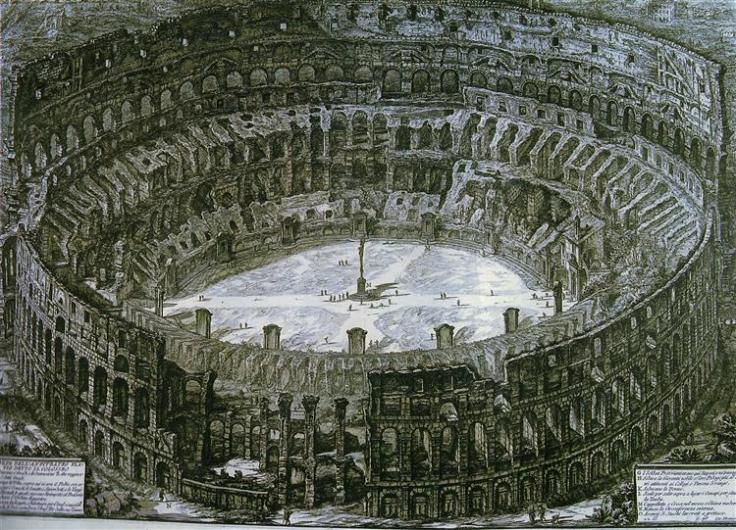
Giovanni Battista Piranesi (the drawing also indicates the stations of the cross).
Around 1995, the famed German epigrapher Géza Alföldy noticed earlier holes from bronze lettering behind a later 5th century CE inscription on an architrave (CIL VI, 40454a) for the Colosseum. The earlier lettering holes dated to 79-80 CE. The inscription notes that the building project was the will of the Flavian emperor Vespasian (though it would be dedicated by his son, Titus), but also that the amphitheater was itself a monument to his subjugation of the Jewish people in the First Jewish War (66-73 CE):
I[mp(erator)] Caes(ar) Vespasi[anus Aug(ustus)]
amphitheatru[m novum?]
[ex] manubi(i)s [fieri iussit?]
Imperator Caesar Vespasian Augustus ordered
a new amphitheater to be made from the spoils of war.
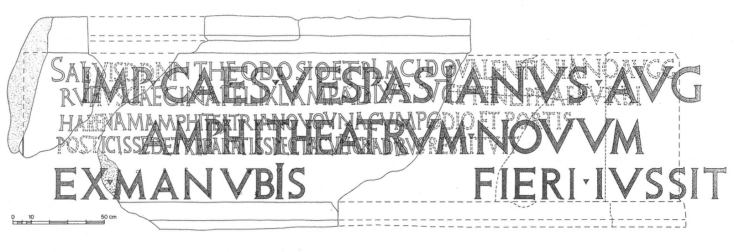
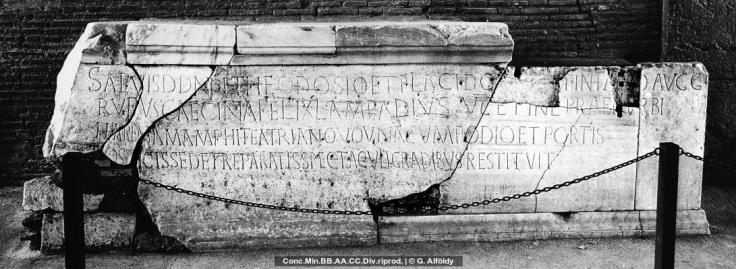
Vespasian’s choice of the Latin word ‘manubia‘ (war spoils) for the earlier architrave inscription is here telling and would have announced to the Roman populace that, much like the nearby Arch of Titus later built from 81-82 CE, the Flavian amphitheater testified to imperial power within a new dynasty. I was reminded of this use of spolia recently while reading Nandini Pandey’s new book, The Poetics of Power in Augustan Rome, which remarks on how Roman generals (Augustus included) attempted to make ephemeral acts like the triumphal procession through the city more concrete through the use of building projects:
Triumphing generals, of course, had always tried to make this ephemeral spectacle last by dedicating spoils, issuing coins, and building temples ex manubiis [‘out of the spoils of war], acts that culminate in the Palatine and Forum Augustum.
The Colosseum’s architrave inscription noting the use of spoils must then be reconciled with the Jewish historian Josephus’ Bellum Judaicum (6. 420), a history of the Jewish War which noted: “Now the number of those that were carried captive, during this whole war, was collected to be ninety-seven thousand. As was the number of those that perished during the whole siege eleven hundred thousand.” Many of these Jewish captives were sold to mangones (slave traders) and then sent out to the provinces and to the city of Rome in order to be exhibited and killed within gladiatorial arenas across the empire. We know from Josephus that 2,500 Jewish captives fought and died in the gladiatorial games in Caesarea alone. Evidence from Pompeii also indicates there were Jewish gladiators who likely fought in the arena there; thus it was not just Christians who died in the sands of Roman amphitheaters.
In an earlier post discussing the use of unfree labor in order to build sports arenas from Qatar for the 2022 World Cup, I discussed the ways in which we should appreciate and understand structures built by enslaved persons in antiquity and today. From the Cloaca Maxima, Rome’s massive sewer, to the campus of the University of Virginia, enslaved and unfree laborers have given their lives to build structures we continue to appreciate. I suppose all I am asking today is that the thousands of tourists who visit the Colosseum this summer remember the Jewish people who similarly died to fund the games and structures of the Roman Empire. It was their lands and bodies which were subjugated in order to fund the great Colosseum–even if the structure came to be associated with Christian martyrdom.
Architrave Inscription:
Epigraphic Database Heidelberg (EDH): HD025559
Epigraphic Database Roma (EDR): EDR092904; EDR109752.
Bibliography:
Alföldy, Géza, “Eine Bauinschrift aus dem Colosseum,” in ZPE 109, 1995, pp.195-226.
Beard, Mary and Keith Hopkins, The Colosseum (Harvard University Press, 2011).
Boyle, A.J. ““Introduction: Reading Flavian Rome,” in A.J. Boyle and W. J. Dominik (eds.), Flavian Rome: Culture, Image, Text (Brill Press, 2002).
Feldman, Louis H. “Financing the Colosseum,” Biblical Archaeology Review; Jul/Aug 2001; 27, 4 [PDF]
Levey, Irving M. “Caesarea and the Jews.” Bulletin of the American Schools of Oriental Research. Supplementary Studies, no. 19 (1975): 43-78. http://www.jstor.org/stable/20066617.
Orlandi, Silvia. Epigrafia anfiteatrale dell’occidente romano. VI. Roma. Anfiteatri e strutture annesse con una nuova edizione e commento delle iscrizioni del Colosseo. Vetera, 15. Roma: Quasar, 2004.
Rocca, Samuele, “A Jewish Gladiator in Pompeii?” Materia Giudaica 11,1-2 (2006), pp. 287-301.
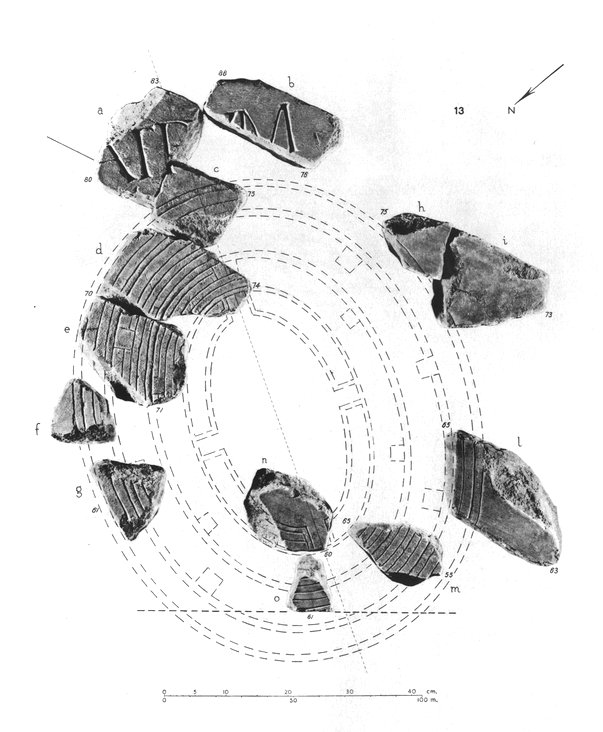

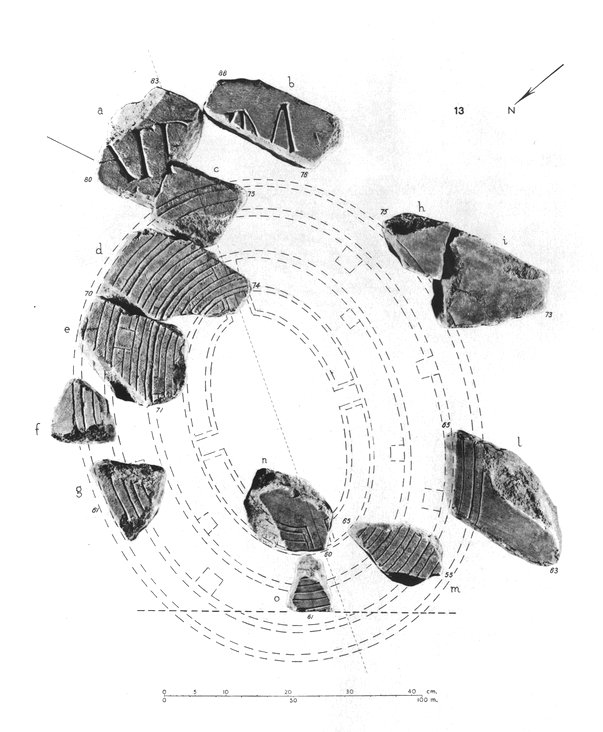
Feldman, Louis H.
Financing the Colosseum
Biblical Archaeology Review 27,4 (2001) 20-31, 60-61
With the spoils from the Jerusalem Temple.
Jews — Rome — History
Thank you! I will add this, though the article itself seems to be behind a paywall, so I cannot read it. https://www.baslibrary.org/biblical-archaeology-review/27/4/1
It is fascinating how ancient history continues to inform and provide context for the present.
If you would like, i can send you the Feldman/Bar article, Dr. Bond. I follow you on Twitter; just DM me
I found a PDF of it last night and read it! Many thanks. I have now added it to the bibliography. Gratias ago tibi.